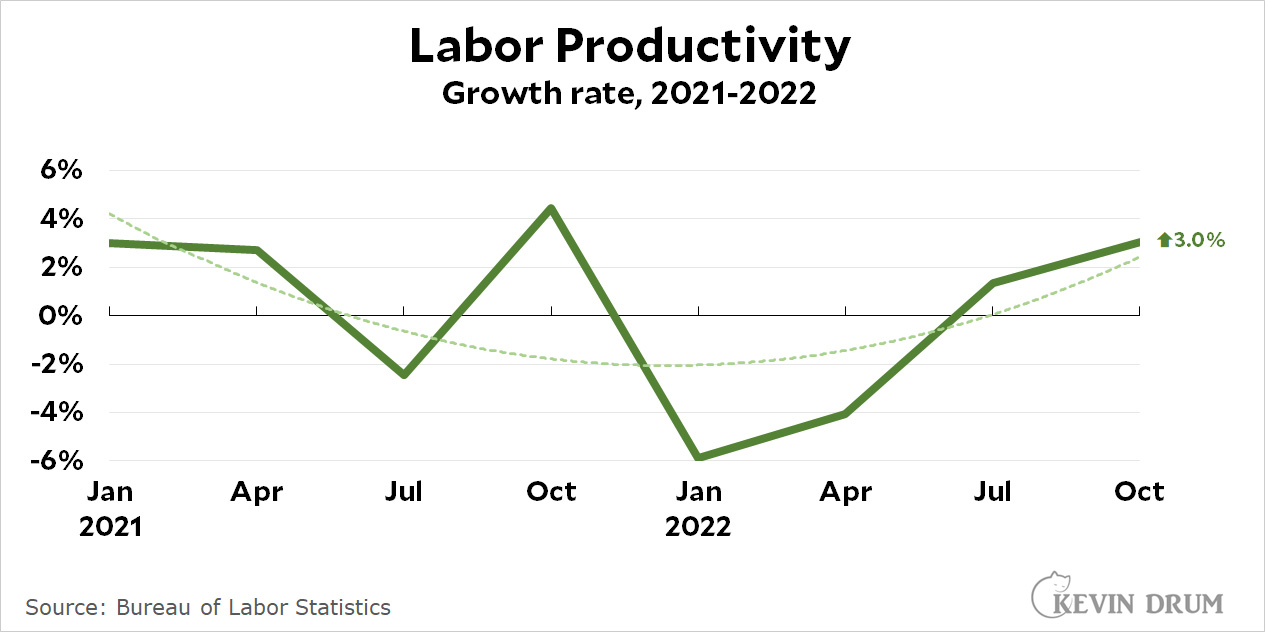There are those who say that the single most important economic indicator is labor productivity. In the long run, increasing the amount of stuff each worker can produce is the key to economic growth—and that includes wages, GDP, corporate profits, and everything else.
Here's the latest reading on labor productivity:
 There was a big jump in productivity at the start of the pandemic because lots of people got furloughed but output stayed relatively high. After a couple of quarters it flattened out but stayed considerably higher than the pre-pandemic trend. In the most recent quarter productivity rose a bit, putting us at almost exactly the same level as mid-2020. It's still above trend, but growth over the past couple of years has been zero.
There was a big jump in productivity at the start of the pandemic because lots of people got furloughed but output stayed relatively high. After a couple of quarters it flattened out but stayed considerably higher than the pre-pandemic trend. In the most recent quarter productivity rose a bit, putting us at almost exactly the same level as mid-2020. It's still above trend, but growth over the past couple of years has been zero.
But let's zoom in to those years and look at the growth rate of productivity:
 Productivity growth is a very noisy series, so the trendline is less informative than it is for some other things. Nevertheless, the productivity growth rate was a solid 3.0% last quarter and the growth trend has picked up over the past year. That's good news.
Productivity growth is a very noisy series, so the trendline is less informative than it is for some other things. Nevertheless, the productivity growth rate was a solid 3.0% last quarter and the growth trend has picked up over the past year. That's good news.

The best part of increased worker productivity is that most of the fruits of those gains go to the shareholders and upper management!
Start making more money weekly. This is valuable part time work for everyone. The best part ,work from the comfort of your house and get paid from $10k-$20k each week . Start today and have your first cash at the end of this week. Visit this article
for more details.. https://createmaxwealth.blogspot.com
Is labor productivity more important than GDP? It is GDP divided by hours worked. Overall the most important simple measure is probably GDP/capita. This folds in demographics. If you can keep GDP/capita increasing despite population decline and aging, you are doing well. Japan has actually been doing this, and there is no good reason that China can't keep doing it given where it is now (low GDP/capita).
Labor productivity is above all a measure of how much investment and automation there is - machines doing the work instead of people. It is not normally a measure of how hard or how long people work. Hours is in the denominator, so increasing work hours does not increase worker productivity and may reduce it unless output is increased proportionately to hours. China and other developing countries have a great deal of room for improvement in automation overall.
Of course these calculations do not put a value on leisure. What good is it to have a lot of stuff unless you have time to enjoy it? If everybody worked a 4-day week instead of 5-day this would not decrease labor productivity, although it would probably decrease GDP/capita.
And the simple measures do not take account of inequality - most people in the US are not getting their share of the increased stuff. Since the 70's most of the numerical increase in productivity has been going to upper incomes, especially the 1%. A better measure might be the fraction of GDP going to the median income persons.
A slight quibble. If you measure the fraction of GDP going to the median income person, the fraction will be in inverse proportion to the size of the population. What you want is the amount that the median income person receives as a fraction of GDP per capita.
Another good measure is simply the fraction of GDP that goes to wages and salaries, as opposed to investment income. Pensions are simply deferred pay, so I would count pension payments as the equivalent of wages and salaries.